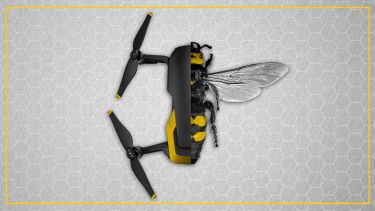Revolutionising autonomous technology with the brain of a bee
Nature will always find the simplest way to do something and often we can take inspiration from it. This is the case for autonomous technology, where bees are providing a solution to the problems it faces.

As bees search for flowers to pollinate they are constantly navigating their surroundings, meandering round the trees and ever increasing buildings in their way. But the high-level neurological functions that prevent them from flying into a building for example, have remained a mystery. However, when Professor James Marshall and his team began developing autonomous technology they uncovered the neuron pathways in the bee’s brain that enables this navigation behaviour.
A key aspect of this is optic flow. It’s a way of measuring how objects move across our visual field. “Bees use motion to not only work out if they’re going to hit something but how far away something is,” explains Dr Alex Cope, a researcher from the University of Sheffield. By building up this information about bees innate navigation systems James and his team have been able to produce algorithms that replicate the bee’s processes. Essentially they have replicated the brain of a bee which can then be used as the ‘brain’ of autonomous technology.
This breakthrough has the potential to revolutionise current autonomous-systems technology that is currently governed by the deep learning processes of artificial intelligence. “The problem with deep learning processes is that you train the technology so there’s no way of knowing what it has or hasn’t learnt. Since we’ve essentially designed a brain rather than trained one we’re in a better position to understand what they can and can’t do,” explains James.
Self-driving vehicles are an obvious application for this technology. But drones open up many other possibilities such as precision agriculture where they can be used to deposit microdoses of weed killers onto crops. This results in increased plant yields with reduced chemical impact on the environment.
However, the possibilities go much further especially when considering the current COVID-19 pandemic. Autonomous technology enables daily activities to continue without the need for physical interactions. For example, Amazon are currently trialling last mile delivery using drones and Starship are testing last mile delivery with ground based robots in Milton Keynes. The technology is responsible for delivering parcels which is more flexible, efficient but ultimately safer than human delivery. When autonomous technology is applied to robots it also allows healthcare to be provided without the risks associated with human contact.
The innate navigation system of bees has provided an opportunity for autonomous technology. This approach is far more reliable than any deep learning process of artificial intelligence used so far and leads the way for new technologies and approaches to everyday life. To adapt the Old Testament, you might say our scientists have ‘gone to the bee to be wise’.
